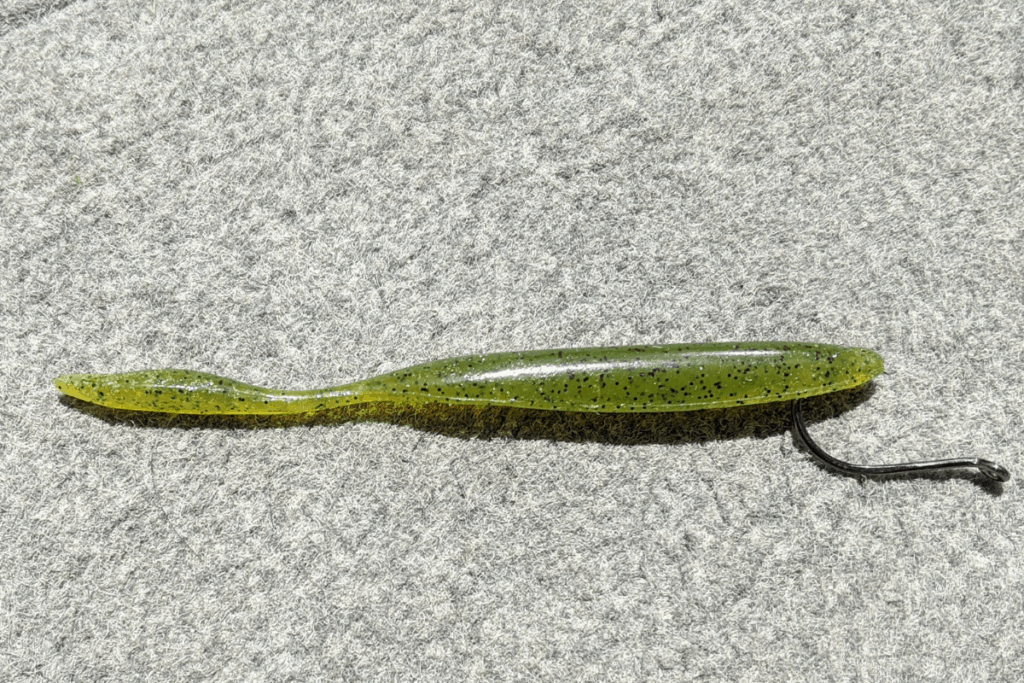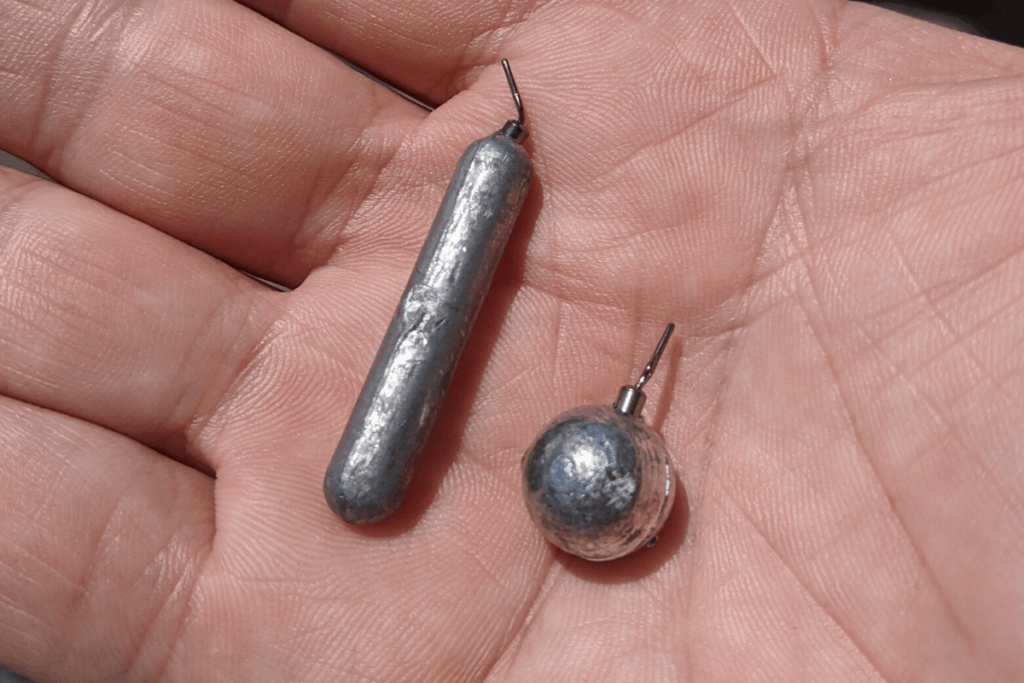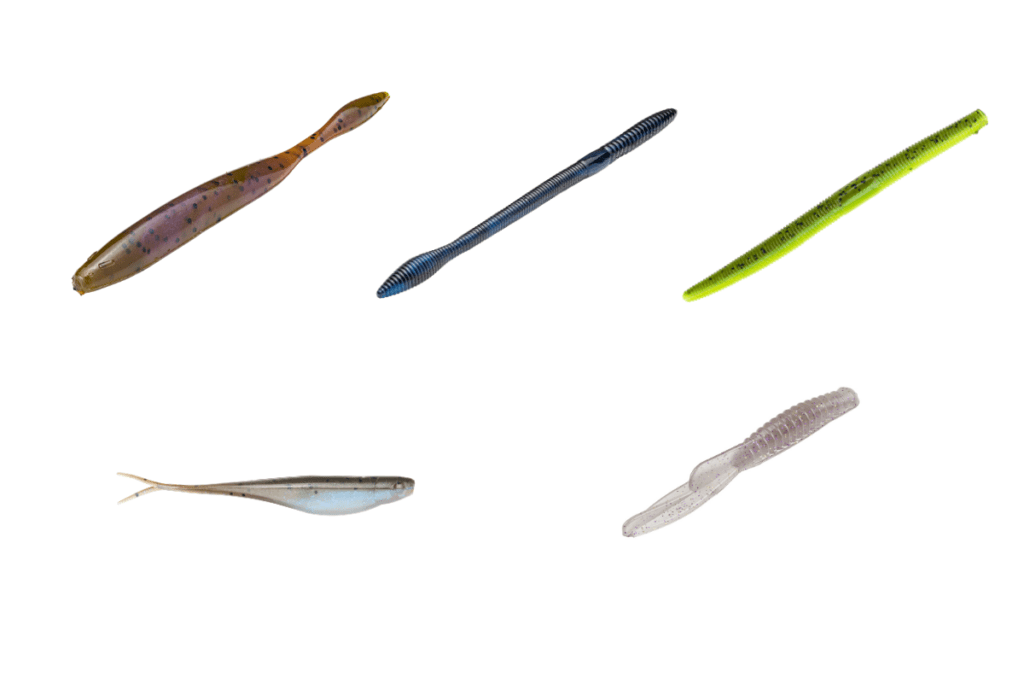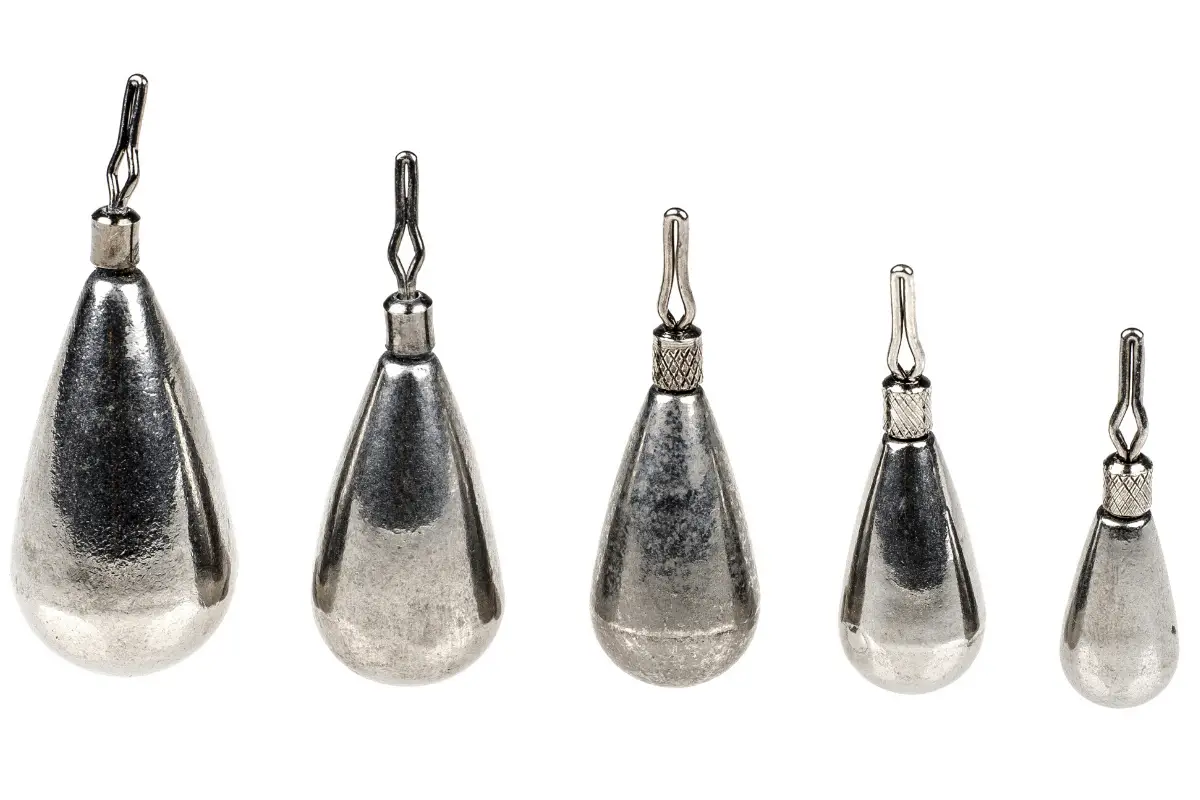A drop shot rig is a staple of professional bass anglers. Why? It works.
To fish a drop shot rig properly, anglers need to rig the weight on a leader below the hook. Leader length can vary. Shorter leaders provide more action on the lure while longer leaders allow for more subtle movement. Just about any soft plastic lure can be used and hooked several ways, including both a Texas Rig method as well as using a traditional nose hook.
In this article, I will break down the drop shot in detail and hopefully even give seasoned anglers some new thoughts about how to present their lures to finicky bass.
History of the Drop Shot Method
This method first made its way to America via Japan. Anglers fishing heavily pressured waters in Japan are constantly developing new lures, techniques, and presentations to trick bass into biting.
The first U.S. anglers started experimenting with the rig in the mid-1990s and it has been a staple of bass enthusiasts ever since.
Most professional anglers will admit that a drop shot rig just catches fish. Period.
What is it?
What really makes this fishing style unique from other presentations is its ability to hold a soft plastic suspended off the bottom. The weight is rigged below the hook and as a result, the bait can be held right in the water column and entice wary bass into biting.
When the drop shot rig first made its mark it was considered only a finesse method.
As anglers have experimented and tweaked the presentation it is now considered to be much more versatile than first thought. It can even be fished on casting gear if the situation calls for it.

How to Rig the Drop Shot
The first thing I do is to attach a swivel to my mainline.
This is not a necessity, but the drop shot tends to create a lot of line twist. The swivel eliminates this and makes for a much more pleasant day of fishing.
You can also use a braid to fluorocarbon or mono leader to help eliminate line twist.
Once the swivel is attached to the mainline, I will pull off about an arm’s length of whatever line I am using for my leader. I usually start with 10lb test mono or fluoro.
Tie the hook with a Palomar knot, placing the hook approximately in the middle of the leader length.
Once, tied, take a tag end of the leader and run it back through the eye of the hook from the top. This is a simple trick to help hold the hook in the upright position.
The leader that was slipped back through the eye of the hook will now be used to attach the drop shot weight.
Take the other end of the leader line and attach it to the swivel.
What Hook to Use for Drop Shot Fishing?
There is a wide range of hooks on the market and many of them can be used for a drop shot rig.
When fishing the traditional finesse style of the rig, I prefer to use a hook designed for drop shotting in the 1, 2, or 1/0 and 2/0 range.
When I fish larger soft plastics on a drop shot rig I have been known to use a hook as large as a 3/0.
How to Hook the Soft Plastic Lure
There are several different methods that anglers can use to rig soft plastics. Each has its own benefits and situations where they excel.
Traditional Nose Hook Method
This is probably the most common rigging option for soft plastics.
It leaves an exposed hook which is great for an excellent hook-up ratio. This type of hooking method also leaves a lot of the plastic free to move around giving it plenty of lifelike action.
A downside of this rigging is its tendency to get caught up in vegetation, wood, etc.
Texas-Rig Method
If you are using a larger soft plastic, like a 5in soft jerkbait, you may wish to rig the lure with a traditional Texas-Rig setup.
The deeper hook penetration into the plastic will help to support the lure in the water column, but it does impede some of the action.
This rigging style is beneficial if fished around lots of vegetation and other cover that may cause issues with an exposed hook.
Wacky Style
There are times when wacky rigging a soft plastic on a drop shot is the exact method needed to garner lots of bites.
This rigging style is also great for times when you want the lure to fall at a much slower pace.

Hybrid Nose Hooking
This last method resorts back to using a small nose hook, but instead of threading the lure through in the traditional manner, you want to feed the hook through the center of the soft plastic and out towards the nose.
Push the hook through about a ¼ to a ½ in from the front of the bait and then feed the hook back through the center of the plastic towards the nose of the lure.
The point of the hook should be just under the surface.
This nose hooking method gives a completely different look to the lure than the previously mentioned style. The lure cannot swing sideways on the hook and is more responsive to movements from the angler.

Weights for Drop Shot Fishing
There are many, many versions of drop shot weights available to anglers today.
There are three standard shapes, the round weight, bell weight, and cylinder weight. Drop shot weights also come in either regular lead or tungsten.
If the water you fish does not have a lot of rock, you can get away with using traditional bell sinkers that do not have the typical drop shot weight-to-line system.
These traditional line systems allow for the weight to slide off if hung and save the angler from retying the entire setup. These types of weights do cost more, so if the lakes and rivers you fish are not apt to hang your weight, feel free to tie on a standard version that will not slide off. It could save you money.
Some drop shot fishermen have also used a split shot and crimp it onto the line.
Round Drop Shot Weights
These weights are best for use in lakes and rivers that have a clean or rocky bottom. The round design allows for more surface contact with the weight and better feel for the angler.
Cylinder Drop Shot Weights
This design is perfect for anglers that are fishing in water that have heavy vegetation.
The slender design of the weight allows it to slide easily through the grass without getting hung up as much as other shapes.
The cylinder style weight is not great for lakes and rivers with a rocky composition. The slim profile drops into cracks and crevices much easier than other designs and often gets stuck.
Tear Drop or Bell Weights
Many manufacturers offer some sort of bell-shaped drop shot weight.
This profile is a nice compromise between the round and cylinder shapes and is a favorite of serious drop shot anglers. It doesn’t pull through the grass as easily as the cylinder weight, but it is a close second.
Tungsten or Lead?
In many areas, this discussion is no longer an issue. Lead has been banned in many waterways and will continue to be phased out.
If you have the choice, there are distinct differences.
Tungsten is much denser than lead and therefore telegraphs a lot more information to the angler. For those who have switched over to tungsten weights, they say they would never go back.
The downside? Price.
Tungsten weights are often 3x the cost of lead weights. Paying $6.00 for two weights is a financial consideration for many anglers. This is especially true when using a method like drop shotting where weights may be lost often.
Presentation
The drop shot rig has been known as a vertical presentation. And for good reason.
When anglers see fish on their electronics, a drop shot is a highly effective method of presenting a lure to fish anywhere in the water column.
In recent years, I believe it is safe to say that more anglers use the drop shot as a cast-and-retrieve type of lure over a vertical-only offering.
The key to using it as a casting lure is to keep the line taught as often as possible. It is OK to let the lure drop once in a while, hop it, or shake it, but the rig works best when the weight is making contact with the bottom and the lure is held up off the lake or river bed and suspended in the water column.
When using a drop shot rig to cast, it is important to think about the rod position. A strike could happen at any time, so keeping the rod at the proper angle to allow for a solid hookset can help avoid a lot of missed strikes.
The hookset is not ferocious, like when using a jig, but there needs to be room to pull the rod. I do my best to not bring the rod tip past a 10 o’clock position when retrieving from a long cast.
Leader Length
There are literally thousands of opinions on leader length.
To put it simply, a longer leader allows more distance between the weight and the lure. This imparts a more subtle action on the soft plastic.
A shorter leader means more action.
Depending on the season, or the mood of the fish, the leader can be adjusted to meet those conditions.
Leader length can also be based on bottom composition. If there are lot of weeds in a lake, a longer leader may be needed to position the lure above the vegetation.
Rocky lake and river beds can get away with a shorter leader.
A good starting point is to use a leader around 18” and adjust from there.
(Here is an article on leader length with underwater examples.)

Drop Shot Lure Selection
When the drop shot rig first made its way to the United States from Japan, most lures associated with the presentation were very small.
These minuscule offerings tempted wary bass to bite and still do.
Anglers in the last two decades have experimented with lure size, shape, color, and design.
It is reasonable to say, that any soft plastic can be used on a drop shot rig. The forage available and fishing pressure are the two largest determining factors.
I have used 5” soft jerkbaits in watermelon when fishing for smallmouth that are chomping on yellow perch. I have also used small 2.5” soft jerkbaits in a pearl color when smallies are devouring alewives.
Other very popular drop shot lures include plastic worms in a variety of sizes, stickbaits, creature baits and tubes.
Experiment with what works best in your waters. Start with something that looks like a potential match for the forage in your area and you are sure to get a bite. Then experiment with colors and rigging options to dial-in what the bass want on that day.
The Rod
Spinning gear is often the preferred equipment when dealing with highly pressured fish and small lures, but baitcasting equipment can be used effectively with larger lures and weights.
For my spinning rod, I like either a medium power rating or a medium-heavy power rating with a moderate tip.
Drop shot hooks are often small and ultra-sharp. Reeling down and applying pressure is all that is needed to get a good hookset.
When scaling up to baitcast equipment for larger lures and hooks, a medium-heavy power rated rod is my go-to.
If I am going to be using the drop shot in a vertical manner trying to catch fish I see on my electronics, I am more apt to use a shorter rod – something less than 7’.
For horizontal casting, I like a rod over 7’ in length. This helps move more line and get the energy transfer to the hook.
Power Shot
Using a power shot rig is quickly becoming something that anglers are utilizing when trying to find fish.
The setup is the same except for the size of the weight. A power shot rig uses drop shot weights in that ½ oz to 1 oz range.
The idea is to get the lure to the bottom quickly, shake it a couple of times, and then reel in and cast again. The method is effective when the bass are on a tough bite and you are trying to locate fish.
A traditional drop shot rig with a small weight takes time to sink and is fished slowly. The power shot rig can get the lure into position much quicker and allows an angler to move right along and cover water.
Final Thoughts
Drop shot fishing works. It catches fish all year and on any body of water. Creative anglers have modified the rig to meet about any situation encountered.
Experiment and see what is best for your fishing style and waters.
Drop a comment below if you have some tips you would like to share.
Tight lines. Be safe and make sure to encourage someone today. You never know how you may change their life forever.
Isaiah 6:8

